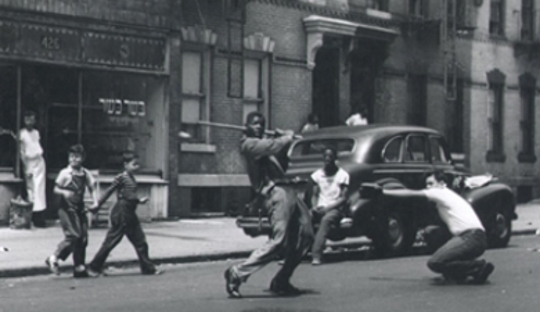 Childhood in the Brooklyn streets influenced Neugeboren’s work, in particular novels like Big Man and Sam’s Legacy.
Childhood in the Brooklyn streets influenced Neugeboren’s work, in particular novels like Big Man and Sam’s Legacy.
.
Sam left the train at Church Avenue. A few blacks guys got out. “Ours is a neighborhood in transition,” Ben had said, and Sam had to laugh. A neighborhood in transition—that was rich. When he’d been there, growing up, it had been mostly Jews, mixed with some Catholics, Irish and German. Sam didn’t mind though. The blacks never hassled him. Maybe the word was out that he had some kind of business with Sabatini. He touched his side pocket. Some guys—his buddy Dutch was one—said you were crazy to keep a blade on you, that if you got cornered and they went for you and found it on you, you’d get it ten times worse. But Sam did what he wanted. He liked feeling the blade’s weight against his thigh.
From Sam’s Legacy 1973
A little more than ten years ago, I asked novelist Jay Neugeboren to take me on a walking tour of Flatbush, the Brooklyn neighborhood he describes above in Sam’s Legacy. I asked because I’d been reading his novels then, pretty obsessively—as I have been reading them again lately—and wanted to get a closer look at the streets that had inspired them. I was interested, too, in the notion of inspiration. Wondering at that particular time (as I am still wondering) about the proposition that we (as writers, as people) are marked by our first glimpses, by the immediate shadows about the crib, the childhood streets, and all our life is an effort if not to escape then to get a better glimpse.
Neugeboren was widely acclaimed early in his career for his portrayal of urban subcultures: for his Cassavetes-like attention to detail, to off the radar characters. In mid-career, he all but disappeared as novelist—not publishing a novel for 20 odd years—until a recent revival prompted in part by small press Two Dollar Radio. This has brought his older work attention and five new novels into print
Neugeboren is an innovative novelist, conjuring forms that defy easy categorization. His characters leap through multiple identities—racial, familial, sexual. He is master of a particular American prose style, one that owes as much debt to European novels as to the dialect of the immigrant streets. It is a style translucent in its lyricism. There is durational quality: in the accumulation of detail, in the way the writing dwells in the moment, in the naturalistic surface. At the same time there is something else: a wash, a tint, a coloration that makes no pretense to realism at all.
.
Jay is a Jewish writer, second generation, born Jacob Mordecai Neugeboren. I first met him in 1980, when I was a student of his at the University of Massachusetts. He was just finishing The Stolen Jew: the central novel in what has become known as The Brooklyn Trilogy.
He was somewhere in his forties then, his hair tight, curly (or that’s the way I remember it), just verging toward grey. Thirty years later, that day in Brooklyn, he possessed (and still does) the gait and manner of a man much younger. He is a small man, athletic by nature. He has high cheekbones, tapered features, a cleared eyed smile.
Flatbush—on that sunny afternoon in April 2006—was a Caribbean neighborhood, West Indian and black, colorful, yes, full of life, but also poverty. The poverty had been there when Jay grew up, though in different ways. Further down Flatbush Avenue— in the heart of the old immigrant hive—the old King’s Movie Palace sat empty and deteriorating, as it had since the mid-seventies. The famed Erasmus High School stood with its gates shuttered and closed.
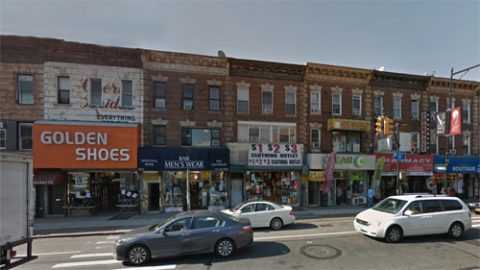 Flatbush Avenue where we walked in 2006
Flatbush Avenue where we walked in 2006
The streets were crowded. A mother in a hurry pushed her baby in its carriage. A cluster of young gangsters stood languid on the corner. Nearby, an old man coughed into his black fist. It was the old Flatbush, but then it wasn’t. Us, loitering there, no matter our histories, we were, in the midst of the new immigrants, no longer Italian, or Jewish, or whatever we imagined. We were white.
This question of identity, it’s allusive and shifting nature, is very much endemic to the streets.
And is very much at the core of Neugeboren’s work.
We went down Martense Street, to the small tenement where Neugeboren had grown up: a two-story building, four tiny apartments, two up, two down. The building stood alongside a number of similar buildings, all red brick, separated by narrow concrete walkways.
I had some idea of what it had been like in the little apartment. Partly because Jay had told me, but also because I’d read about it in his novels—and in the autobiographical memoir centered on his brother, Imagining Robert.
So I had some notion of his family, or felt I did. Of his beautiful mother, the nurse, who supported the family. Of her dalliances (real or imagined). Of his emasculated father, often unemployed. Of his talented, disturbed brother, who spent much of his adult life in the care of New York’s notorious mental health system.
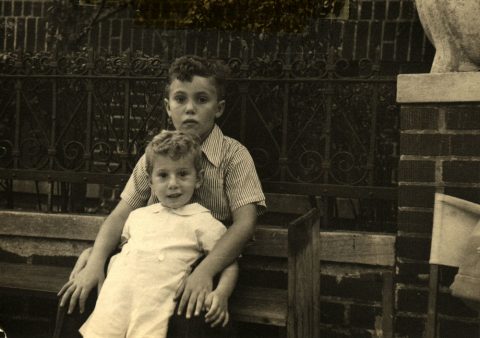 Jay with his younger brother Robert in Flatbush, circa 1945
Jay with his younger brother Robert in Flatbush, circa 1945
As a young boy, Jay told me, he had attended yeshiva nearby. He pointed out the place as we walked (or where it had once been). Where he’d stood at the morning service at schul, his arm wrapped in the tephillin—a strap wound seven times about the arm, binding him to the word of God. At the heart of that word was the great emptiness of the Jewish God—who at once gave everything (all the lives people lived, all the stories, every word), but promised nothing more, no hereafter, only dust. The recognition of God’s word did not offer salvation—at least not in the Roman Catholic sense that I was raised—but was at same time the source of life, inspiration, human compassion.
The streets were full of noise.
We circled through the neighborhood. Though the old parade ground, past long blocks of ball fields and tennis courts. Down into Ditmas Park (an odd oasis of former wealth, of deteriorating Victorian mansions, awaiting gentrification or further decay, it was hard to know). Up Nostrand, down Church, past the library on Linden, circling bookie joints that used to be, drug stores and delis long gone, a grocery transformed into a rummage house, used clothing spilling onto the street.
We ended back on Martense.
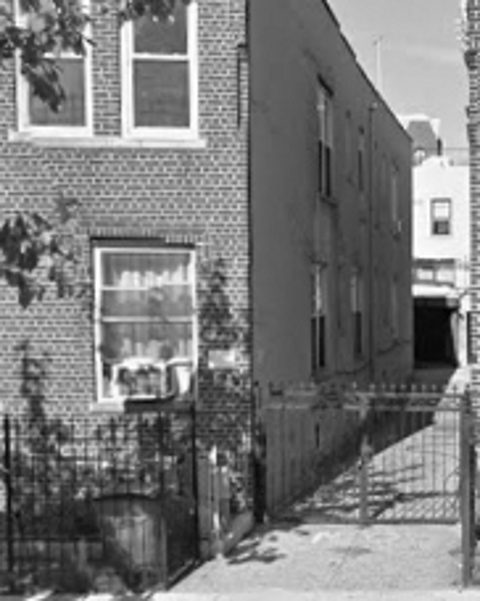 The Martense Street tenement where Neugenboren was raised
The Martense Street tenement where Neugenboren was raised
Jay lived in Manhattan now and wanted another look before we went our separate ways. He went around the building, searching for the window where he and his brother—with whom he had shared a bed in the tiny apartment—used to stand with their noses pressed against the glass.
THE EARLY NOVELS
Then cackles the way he does. Oh yeah, I’m in the big time. Me and Louie’s Leapers, we burning up the league, win seventeen games in a row. These last months, between games and Willa and those sessions with Rosen, you want to keep up with me, you got to run, man.
From Big Man, 1966
Italo Calvino, in speaking about his own first novel, The Path to the Nest of Spiders, said he spent the rest of his career trying to write his way out of the maze, the artistic quandary, he’d created for himself in that first book. Italian American novelist John Fante, author of Ask the Dust, once said pretty much the same thing, referring to his fictional alter ego, Arturo Bandini, who haunted his novels until the end.
In similar ways Jay has never moved very far from his existential subject matter: from Martense Street and his Jewish roots. A world populated by outsiders: small time gangsters, low-lifers, school teachers, orphans, widows, aspiring athletes, passing celebrities, people trying to be good (most of them) but running constantly against their own personal and tribal histories.
Jay’s first novel, Big Man, draws from those streets: the story of a young black man, once a college basketball star, caught in a vortex of self-hatred and shame after getting thrown out of the sport for his involvement in a point-shaving scheme. The story is based in part on real events: a 1950’s New York betting scandal, back when Brooklyn was the epicenter of college basketball. As in real life, the victims were not the bookies and odds makers and college officials who benefitted. The people who took the fall—who bore the brunt of the shame: in the papers, on the streets, and in their lives—were the players themselves, mostly black.
The novel is in a mode akin to the old social realism, but with some of the optimism of Dickens: fatalistic—recognizing the social constraints—but with a character who finds a way to survive. Neugeboren’s second novel, Listen, Ruben Fontanez—based around a racially charged murder—has similar socials concerns, though told from the other end of the ethnic divide, narrated by an aging Jewish school teacher, Harry Meyers, who works in the slums of Brooklyn, mostly with Puerto Rican kids.
Meyers is feverishly ill, moving in and out of consciousness, his living quarters (and his imagination) inhabited by his former students, teenage runaways, kids with nowhere to go. The decaying neighborhood is at once a source of sustenance and an inescapable trap. The way out is deeper in.
.
THE BROOKLYN TRILOGY
“In my early books, I used to pride myself on their “objective” quality. I mean, I don’t think I’d ever done an autobiographical novel in a way that even anyone who knew me could feel. My books always seemed to be very much about other things. I think that was one way, in my own life, of not dealing with certain materials, potentially very rich materials, things that I do know about, but also material that I was afraid of, and felt I couldn’t handle. Now, with The Stolen Jew, I’ve found a subject, a subject that comes from deep personal wells with.”
Neugeboren, circa 1980
In the late sixties, Neugeboren went to the south of France with his first wife, and stayed gone for the better part of two years. Part of the reason, to recreate those Brooklyn streets, he needed physical distance from the place itself.
Jay examined this paradox in Parenthesis: An Autobiographical Journey. (1970): a piece whose original intention had been to chronicle his own career as a political activist. The result was a manifesto of sorts, a personal one, contemplating the limits of realism but also examining his early life in Brooklyn, his scholarship years at Columbia, a forsaken attempt to join mainstream America as an executive trainee for General Motors.
“I was interested in the experimental work going on at the time, in new novelistic forms ” Jay told me. “At the same time there was this personal material—based in a world I knew—that I wanted to explore in my fiction. But I didn’t want to lose other things, from Victorian novels, things that I love, like character and story and plot.”
This result was The Brooklyn Trilogy, so-called because of its deep immersion into the psychological terrain centered on a few corners of Flatbush over the course of fifty years.
The first of these novels, Sam‘s Legacy, concerns a small time gambler who has gotten himself in over his head with an Italian bookie. He lives with his aging Jewish father above a clothing store in the heart of Flatbush.
The novel has a naturalistic surface, but there is a postmodernist structure, involving both an outer story and inner one. While the outer story focuses mostly on Sam the gambler—on his hustle, his efforts to save both himself and his father—there is another story, a found manuscript, a book within the book: My Life and Death in the American Negro League: A Slave Narrative
This novel-within-a-novel takes the form of a memoir written by an aging black man in the neighborhood. The man’s name is Tidewater, and the inner novel tells the story of his career as a star player in the Negro Leagues, where he was known as the “black Babe Ruth.”
At the heart of Tidewater’s tale is his own competition with the real Babe Ruth, who—according to Tidewater at least—hid his own bi-racial roots in order to play in the white leagues. The competition between the two men involves a deep admiration, as well as a hatred, a mix of tenderness and brutality that belies the public image of Ruth, casting his amorous affairs and relentless carousing as the veneer of more complicated sexual and racial identity.
In the end, the inner and outer worlds of Sam’s Legacy dovetail in ways that evoke an underlying paradox that is present throughout The Brooklyn Trilogy.
Personal identity rests on a history that is at once total illusion and immutable fact.
The second novel of The Brooklyn Trilogy, The Stolen Jew, is in many ways a much different kind of novel: a family novel, at first glance—drawing (figuratively if not literally) on Neugeboren’s own family history— a generational tale, part thriller, part meta-fiction, with a ruminative main character, an aging Jewish author in conversation with this brother’s ghost. This is a complex, richly associative novel with multiple plot lines, a formal structure akin to Sam’s Legacy, containing likewise a novel-within-a-novel: this one written by the main character. The book maintains, within its digressions, a forward moving narrative: a romance quest that sends the besieged Nathan from Israel to Flatbush to the old Soviet Union, before bringing him home to his childhood sweetheart.
Along the way, Nathan hatches a plan to recreate one of his own novels in manuscript form: a forgery he hopes to sell on the black market to provide cash for Soviets Jews seeking to emigrate to Israel.
This artistic forgery is very much the kind of thing Neugeboren does in his fiction. Set in an earlier Russia, at the time of czar’s pogrom, it recreates, in part, the family’s own history and a larger social history: a tale reminiscent of Isaac Babel, in which the leading enforcers of anti-Semitism are often the Jews themselves.
With its intricacies, The Stolen Jew achieves the depth, the lulling dreamlike quality of Russian novel. It is a mesh of history and folklore, of literary influence, of rabbinical wisdom, and personal history re-imagined.
The final book in the trilogy, Before My Life Began, starts at the end of World War Two, on the streets of Brooklyn, when the main character, David Voloshin—the son of Jewish gangsters—is twelve years old.
Told in style both translucent and highly colored, it opens like this:
All the men were trying to kiss my mother, so I kept pulling at her dress for us to get away. Pink and blue streamers caught in the dark curls of her hair, and tiny dots of silver, on her bare shoulders, sparkled under the light from the lampposts. In the middle of the street Louie Newman was standing on the hood of Dr. Kaplan’s new Buick, trying to dance with a skinny woman who wore a shimmering black dress, and it seemed to me that the sequins on the woman’s dress glittered like the scales on an enormous fish. I didn’t feel well. I wanted to go home, to be in my own room. I pulled harder and I thought I heard my mother’s dress tear—I stopped pulling at once, scared—but she didn’t seem to notice. Her dress was made of a pale lavender silk-chiffon, dark-purple irises swirling around one another toward the ground. I saw a man’s lips pressed against her lips, but she was laughing too hard for him to keep them there. I’d never seen so many happy people before in my life. Everybody was dancing and singing and shouting and hugging each other and throwing paper into the air. Above the noise and the lights and the stores and the apartments buildings the sky was black. Where was my father? Could I tell him, later, what my mother was doing with the men? Would he see that her lipstick was smeared at the corners of her mouth?
Later, as a young man—caught up in the endless triangles of his family —David ends up killing a man from a rival gang. He flees Brooklyn, adopting a new identity as Aaron Levine, a teacher and civil rights activist working in the South.
There is more darkness and violence ahead, a struggle towards synthesis, the imaginary moment when David will return him to reclaim his identity. When he will take his children to his old neighborhood and show them where he grew up. The alley, the concrete courtyard, the four small rooms of the apartment. In that moment, he sees himself walking through that apartment with his boys, room by room. The rooms are clean, white, empty. Freshly painted, full of light.
In this vision, if only for a moment (and only in the imagination), the world of the Brooklyn Trilogy—of Martense Street, of familial struggle and racial conflict—is transformed.
.
After its publication in 1984, Jay wouldn’t publish another novel for more than two decades.
When it appeared, in 2005, this new novel, entitled 1940, was featured in the LA Times Book Review, in a front page article that served to re-introduce Neugeboren to mainstream literary consciousness.
In the decade since, there has followed an intense period of productivity, rare for a writer at any stage of his career, including two collections of stories and five new novels.
None of these is set in Brooklyn.
.
BEYOND FLATBUSH
1940 concerned itself with a woman in search of her lost son, a young man recently missing from a mental asylum. She is aided in her search by a refugee from a different kind of madness, Dr. Eduard Bloch: the Jewish doctor who, in real life, had worked as Hitler’s childhood physician—and whom Hitler allowed to emigrate to the U.S. so that he might escape the death camps.
Hitler’s gesture of kindness, his unexpected humanity, exemplifies the kind of irony that continues to drive Neugeboren’s fiction. He may no longer be writing about Brooklyn, but one recognizes the terrain, the walls of an inescapable maze, as Calvino would have it.
.
But what about the long period between novels? That gap of twenty odd years?
It’s tempting to regard those years as a kind of prolonged version of that parenthetical time in Southern France. There is some truth to that, I believe, as Jay wrote a good deal of non-fiction during this period, including Imagining Robert, the memoir which captures his brother’s struggle with madness.
I asked Jay if—during that long period between novels—he had given up on the form.
Jay shook his head.
“A novelist’s career is a ragged thing,” he said. “It isn’t a straight line. You disappear for a while (or seem to). Then suddenly, you are in fashion again (or seem to be). Who knows why? . . . Inspiration, I don’t know . . . You are given your material, or you find it, by sitting down, by pursuing it . . . Publishing is a tough business, a strange business, but ultimately it is what it is. For me, if I am writing every day—and I’m always writing—I’m a happy guy.”
.
One of Neugeboren’s most recent novels, The American Sun & Wind Moving Picture Company (2013,) is also among his most daring and magical, alternately dark and light, at once innovative in form and highly narrative.
It tells the story of a Jewish family wandering like gypsies about the American countryside—with a horse, a wagon and a hand crank camera—engaged in the making of silent films. The action begins on a frozen lake outside Fort Lee, New Jersey, in 1915, and eventually migrates to the orange groves of Hollywood. Set during the silent film era, it has the structure and feel of a silent film itself—and characters with the same kind of eerie luminescence.
The family possesses a psychology not unfamiliar to Neugeboren’s readers. There is the beautiful mother, and the three men who adore her: her son, her husband, her husband’s brother.
The mother is the glamorous star, and Joey, the son, is his mother’s favorite, “born too beautiful to be a boy.” He takes up cross-dressing, playing the part of a girl in the silent films: a role he takes on more often (and with increasing pleasure) as he grows older. Eventually he achieves stardom himself, not as a man but as woman.
As in Shakespearean drama, the swapping of gender identities is a foil for romance: in this case a romance where the androgyny of the characters is part of their nature, at once wonderful and dangerous, precipitating—as in the world of silent film itself—sudden and calamitous action.
To our jaded eyes, the abrupt transitions of silent film seem herky-jerky; through the lens of this novel they again appear magical. Sure, these are baroque, post-Victorian plotlines (though their abrupt and startling violence sometimes surpasses Quentin Tarantino), but the author’s point is to prove just how much this consummate artistry can persuade us to accept. The swift and daring transitions in this narrative are like the punches of a welterweight, moving almost too fast for the eye to follow; they give this very short novel the impact of a work twice its length. —Madison Smartt Bell. Boston Globe
.
Jay’s latest novel Max Baer And The Star Of David (2016) is similarly compact, similarly swift. It takes the form of a historical document: a handwritten transcript—the deathbed account of a life spent in the shadow of legendary boxer Max Bear Sr. as told by his black sparring partner.
In the novel, as in life, Max Baer Sr. was a paradoxical figure: a brutally powerful boxer with a jovial public persona. Not so jovially, he had beaten an opponent to death in the ring—at Recreation Park in San Francisco—with a half-dozen full-blooded punches to the head. Despite his sorrow, this did not end his career. He was a showman, charismatic, alternately generous and mindlessly selfish, popular with women, handsome, childlike and clownish, as apt to play the joker as the brute. In preparation for a bout with the German boxer, Max Schmeling, he had the Star of David sewn onto his boxing trunks. A publicity stunt, maybe. Or because he was part Jewish (or so he claimed) and wanted to emphasize this fact before he climb into the ring to beat the Third Reich’s favorite boxer.
The real meat of this deathbed memoir, though, is in the off stage moments, the interactions between the black sparring partner and Max Baer Sr., a friendship that starts because of Baer’s interest in the man’s Creole sister. The relationship plays out partly in the bedroom— in an increasingly incestuous ménage a trois—but also in the sparring ring, where the men go after one another in ways both vicious and oddly tender.
All of this, of course, echoes the encounters between Babe Ruth and Tidewater in Sam’s Legacy, examining the dualities of racial and sexual identity, the nature of erotic and familial love, the intertwining of violence and compassion.
The same shadows, the infinite shadows, cast upon the childhood streets.
.
The last time I saw Jay was in his apartment in Manhattan. I was passing through the city on my way home to California. We drank Jay’s vodka and ate prosciutto and cheese that I had bought earlier in Little Italy. It was the middle of winter and very cold. We talked about books, about family, about writing. Jay was finishing up the Max Baer novel. Myself, I was between projects, in a bit of maze, just having finished what I thought would be the final book of crime series set in North Beach, the old Italian neighborhood in San Francisco. I wasn’t sure what I would do next, and pretended not to be worried about it.
The phone rang. It was one of Jay’s sons, Eli.
Jay is the father of the three. Divorced in mid-life, he raised his children—two boys and a girl—pretty much on his own. You can see shades of the children in the books Jay has written.
While he talked to his son, I admired on the shelf the outermost figure in a set of Russian dolls: a hollow wooden figurine, painted like a Russian peasant, that twisted open to reveal another smaller but identical doll within, and another within that, and another. There had been reference to these toys inside of one of Jay ‘s novels, I thought—inside one of those stories within stories—and this infinite regression brought to my mind (then or now, it doesn’t matter) the beginning of Sam’s Legacy, the ritual wrapping of the telephin, imagined by Sam when, in that opening sequence, he is surrounded by the crowd at the Garden: fans, gamblers, a collective yearning, a noise rising up out of the nothingness.
I was holding the innermost of these wooden dolls when Jay got off the phone.
“What are you doing?”,
I shrugged.
The way he looked at me—the way it seems to me now —I was the young man in the synagogue. Never mind I was raised in a different religion, on streets far away.
I stood with the doll in my hand.
“Open it.”
I did. Jay smiled.
It was deliciously empty.
—Domenic Stansberry
.
DOMENIC STANSBERRY is an Edgar Award winning author of ten novels. His most recent,The White Devil, is a sultry, decadent thriller concerning a young American woman in Rome who finds herself implicated in series of crimes dating back to her childhood. The book was just named finalist for both the 2017 Hammett Prize and Foreword’s Indie Book of the Year. Stansberry’s other work includes the North Beach Mystery Series, which received wide praise for its portrayal of the ethnic and political subcultures of San Francisco. Books from that series include The Ancient Rain, named several years after its original publication as one of the best crime novels of the decade by Booklist. He received the Edgar for The Confession, a controversial neo-noir centered on a Marin County psychologist accused of murdering his mistresss.
First print rights to this article provided to Numéro Cinq from the PFLA Newswire, a project of the Pacific Film and Literary Association, a 501(3c) non-profit.





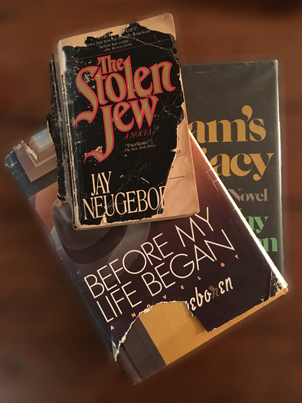
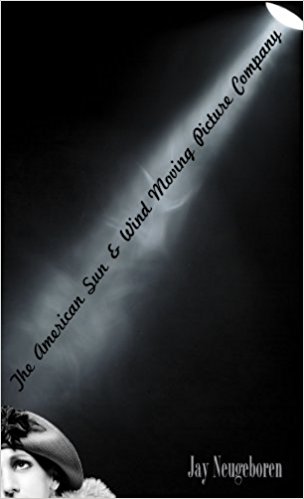
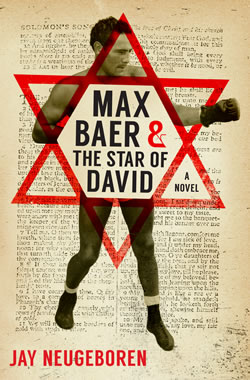
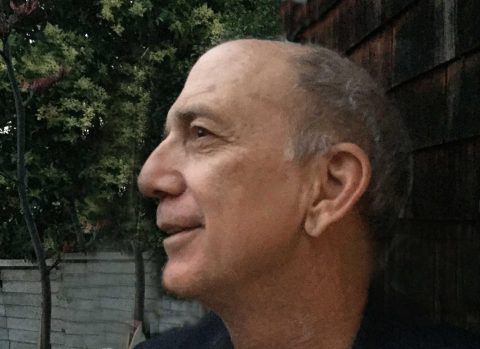
Really happy to see this piece about Jay Neugeboren (I’d have to go to the top to see if this is spelled correctly) because he is a very fine writer and has successfully negotiated the ups and downs of being a writer.
Congratulations for that beautiful piece on Jay Neugeboren’s work. I’m so happy to read about him, about his past, so glad to see this tender picture of him and Robert, and all the others, and all of this in a magazine I didn’t know, with a French title—even with the accent on the “é”! Great discovery!
An interesting, informative review of Jay’s books and insight into who he is. Who is he? A wonderful man and a really excellent writer!